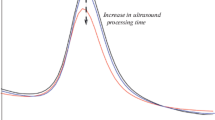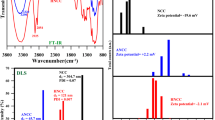Abstract
It is known that swelling of Nafion polymer membrane in water is accompanied by unwinding of polymer fibers into the bulk of the surrounding liquid. This effect is controlled by the deuterium content in water. In this paper, we report the results of studying the adsorption dynamics of methylene blue (MB) dye on the Nafion surface for MS solutions based on natural water (deuterium content 157 ppm, unwinding effect occurs) and based on deuterium-depleted water (DDW; deuterium content 3 ppm, unwinding effect is absent). In addition, we investigated the water desorption dynamics upon drying a Nafion polymer membrane after soaking in an MB solution based on natural water and DDW. It turned out that the MB adsorption rate in MB solutions based on natural water is lower than in the DDW-based MB solutions. Finally, the water desorption upon drying was found to be accompanied by a change in the Nafion absorption spectrum. Specifically, upon water desorption, the low-frequency band of the doublet in the range from 600 to 800 nm in the absorption spectrum of Nafion with MB particles on its surface undergoes transformation with a shift to the short-wavelength region. This transition occurred earlier for Nafion soaked in a DDW-based MB solution. The found effects are related to the retardation of diffusion processes in the layer of polymer fibers unwound near the membrane surface. Thus, changing the deuterium content in the aqueous solution in which the polymer membrane is swollen by very small steps (from 3 to 157 ppm), one can control the dynamics of adsorption and desorption processes.










Similar content being viewed by others
REFERENCES
K. A. Mauritz and R. B. Moore, “State of understanding of Nafion,” Chem. Rev. 104 (10), 4535–4585 (2004). https://doi.org/10.1021/cr0207123
N. A. Belov, D. S. Pashkevich, A. Yu. Alentiev, and A. Tressaud, “Effect of direct fluorination on the transport properties and swelling of polymeric materials: A review,” Membranes 11 (9), 713 (2021). https://doi.org/10.3390/membranes11090713
A. M. Samsudin, M. Bodner, and V. Hacker, “A brief review of poly(vinyl alcohol)-based anion exchange membranes for alkaline fuel cells,” Polymers 14 (17), 3565 (2022). https://doi.org/10.3390/polym14173565
C. Tsioptsias, G.-R. P. Foukas, S.-M. Papaioannou, E. Tzimpilis, and I. Tsivintzelis, “On the thermochemical transition depression of cellulose acetate composite membranes,” Polymers 14 (16), 3434 (2022). https://doi.org/10.3390/polym14163434
D. N. Chausov, V. V. Smirnova, D. E. Burmistrov, R. M. Sarimov, A. D. Kurilov, M. E. Astashev, O. V. Uvarov, M. V. Dubinin, V. A. Kozlov, M. V. Vedunova, M. B. Rebezov, A. S. Semenova, A. B. Lisitsyn, and S. V. Gudkov, “Synthesis of a novel, biocompatible and bacteriostatic borosiloxane composition with silver oxide nanoparticles,” Materials 15 (2), 527 (2022). https://doi.org/10.3390/ma15020527
M. E. Astashev, R. M. Sarimov, D. A. Serov, T. A. Matveeva, A. V. Simakin, D. N. Ignatenko, D. E. Burmistrov, V. V. Smirnova, A. D. Kurilov, V. I. Mashchenko, P. I. Ivashkin, O. V. Uvarov, V. V. Voronov, A. V. Shkirin, E. V. Nagaev, A. D. Efimov, V. E. Ivanov, V. I. Bruskov, M. V. Dubinin, M. G. Sharapov, V. A. Kozlov, N. F. Bunkin, M. Yu. Volkov, M. V. Vedunova, M. B. Rebezov, A. A. Semenova, A. B. Lisitsyn, A. P. Glinushkin, D. N. Chausov, and S. V. Gudkov, “Antibacterial behavior of organosilicon composite with nano aluminum oxide without influencing animal cells,” React. Funct. Polym. 170, 105143 (2022). https://doi.org/10.1016/j.reactfunctpolym.2021.105143
D. E. Burmistrov, A. V. Simakin, V. V. Smirnova, O. V. Uvarov, P. I. Ivashkin, R. N. Kucherov, V. E. Ivanov, V. I. Bruskov, M. A. Sevostyanov, A. S. Baikin, V. A. Kozlov, M. B. Rebezov, A. A. Semenova, A. B. Lisitsyn, M. V. Vedunova, and S. V. Gudkov, “Bacteriostatic and cytotoxic properties of composite material based on ZnO nanoparticles in PLGA obtained by low temperature method,” Polymers 14 (1), 49 (2022). https://doi.org/10.3390/polym14010049
R. Canaparo, F. Foglietta, T. Limongi, and L. Serpe, “Biomedical applications of reactive oxygen species generation by metal nanoparticles,” Materials 14 (1), 53 (2021). https://doi.org/10.3390/ma14010053
P. Mu, T. Dong, H. Jiang, M. Jiang, Z. Chen, H. Xu, H. Zhang, and G. Cui, “Crucial challenges and recent optimization progress of metal–sulfur battery electrolytes,” Energy Fuels 35 (3), 1966–1988 (2021). https://doi.org/10.1021/acs.energyfuels.0c04264
A. Kodir, S.-H. Shin, S. Park, M. R. Arbi, T.-H. Yang, H. Lee, D. Shin, and B. Bae, “Macromolecular antioxidants for chemically durable polymer electrolyte fuel cell membranes,” Int. J. Energy Res. 46 (6), 7186–7200 (2022). https://doi.org/10.1002/er.7607
Z.-M. Xiong, M. O’Donovan, L. Sun, J. Y. Choi, M. Ren, and K. Cao, “Anti-aging potentials of methylene blue for human skin longevity,” Sci. Rep. 7, 2475 (2017). https://doi.org/10.1038/s41598-017-02419-3
A. J. W. te Velthuis, S. H. E. van den Worml, A. C. Sims, R. S. Baric, E. J. Snijder, and M. J. van Hemert, “Zn2+ inhibits coronavirus and arterivirus RNA polymerase activity in vitro and zinc ionophores block the replication of these viruses in cell culture,” PLoS Pathog. 6 (11), e1001176 (2010). https://doi.org/10.1371/journal.ppat.1001176
D. H. Alamdari, A. B. Moghaddam, S. Amini, A. H. Alamdari, M. Damsaz, and A. Yarahmadi, “The application of a reduced dye used in orthopedics as a novel treatment against coronavirus (COVID-19): A suggested therapeutic protocol,” Arch. Bone Jt. Surg. 8 (1), 291–294 (2020). https://doi.org/10.22038/abjs.2020.47745.2349
N. Dabholkar, S. Gorantla, S. K. Dubey, A. Alexander, R. Taliyan, and G. Singhvi, “Repurposing methylene blue in the management of COVID-19: Mechanistic aspects and clinical investigations,” Biomed. Pharmacother. 142, 112023 (2021). https://doi.org/10.1016/j.biopha.2021.112023
D. Bojadzic, O. Alcazar, and P. Buchwald, “Methylene blue inhibits the SARS-CoV-2 Spike—ACE2 protein–protein interaction—a mechanism that can contribute to its antiviral activity against COVID-19,” Front. Pharmacol. 11, 600372 (2021). https://doi.org/10.3389/fphar.2020.600372
V. Cagno, C. Medaglia, A. Cerny, T. Cerny, A. C.‑A. Zwygart, E. Cerny, and C. Tapparel, “Methylene Blue has a potent antiviral activity against SARS-CoV-2 and H1N1 influenza virus in the absence of UV-activation in vitro,” Sci. Rep. 11, 14295 (2021). https://doi.org/10.1038/s41598-021-92481-9
A. Alemany, P. Millat-Martinez, M. Corbacho-Monné, P. Malchair, D. Ouchi, A. Ruiz-Comellas, A. Ramírez-Morros, J. R. Codina, R. A. Simon, S. Videla, G. Costes, M. Capdevila-Jáuregui, P. Torrano-Soler, A. S. José, G. B. Papell, J. Puig, A. Otero, J. C. R. Suarez, A. Z. Pellejero, F. L. Roca, O. R. Cortez, V. G. Garcia, J. Vidal-Alaball, A. Millan, E. Contreras, J.-R. Grifols, À. Ancochea, I. Galvan-Femenia, F. P. Ferreira, M. Bonet, J. Cantoni, N. Prat, J. Ara, A. F. Arcarons, M. Farré, E. Pradenas, J. Blanco, M. À. Rodriguez-Arias, G. F. Rivas, M. Marks, Q. Bassat, I. Blanco, B. Baro, B. Clotet, and O. Mitjà for the CONV-ERT Group, “High-titre methylene blue-treated convalescent plasma as an early treatment for outpatients with COVID-19: A randomised, placebo-controlled trial,” Lancet Respir. Med. 10 (3), 278–288 (2022). https://doi.org/10.1016/S2213-2600(21)00545-2
N. F. Bunkin, P. N. Bolotskova, V. A. Kozlov, M. A. Okuneva, and N. V. Penkov, “Dynamics of polymer membrane swelling in an aqueous suspension of amino acids. The role of isotopic composition,” Phys. Wave Phenom. 30 (3) 196–208 (2022). https://doi.org/10.3103/S1541308X22030025
N. F. Bunkin, P. N. Bolotskova, V. A. Kozlov, and M. A. Okuneva, “Ultra-low-frequency oscillations of luminescence intensity for a polymer-membrane in aqueous salt solutions. Dependence on the isotopic composition,” Phys. Wave Phenom. 30 (4) 242–255. (2022). https://doi.org/10.3103/S1541308X22040021
B. W. Ninham, P. N. Bolotskova, S. V. Gudkov, E. N. Baranova, V. A. Kozlov, A. V. Shkirin, M. T. Vu, and N. F. Bunkin, “Nafion swelling in salt solutions in a finite sized cell: Curious phenomena dependent on sample preparation protocol,” Polymers 14 (8), 1511 (2022). https://doi.org/10.3390/polym14081511
H. Craig, “Standard for reporting concentrations of deuterium and oxygen-18 in natural waters,” Science 133 (3467), 1833–1834 (1961). https://doi.org/10.1126/science.133.3467.1833
D. S. Goodsell, The Machinery of Life (Springer-Verlag, New York, 2009). https://doi.org/10.1007/978-0-387-84925-6
I. A. Khawar, J. H. Kim, and H.-J. Kuh, “Improving drug delivery to solid tumors: Priming the tumor microenvironment,” J. Controlled Release 201, 78–89 (2015). https://doi.org/10.1016/j.jconrel.2014.12.018
B. A. Buhren, H. Schrumpf, N.-P. Hoff, E. Bölke, S. Hilton, and P. A. Gerber, “Hyaluronidase: From clinical applications to molecular and cellular mechanisms,” Eur. J. Med. Res. 21, 5 (2016). https://doi.org/10.1186/s40001-016-0201-5
N. Nagy, H. F. Kuipers, A. R. Frymoyer, H. D. Ishak, J. B. Bollyky, T. N. Wight, and P. L. Bollyky, “4-Methylumbelliferone treatment and hyaluronan inhibition as a therapeutic strategy in inflammation, autoimmunity, and cancer,” Front. Immunol. 6, 123 (2015). https://doi.org/10.3389/fimmu.2015.00123
H. M. Shepard, “Breaching the castle walls: Hyaluronan depletion as a therapeutic approach to cancer therapy,” Front. Oncol. 5, 192 (2015). https://doi.org/10.3389/fonc.2015.00192
S. Rezaei-Zarchi, A. A. Saboury, and A. Javed, “Characterization study for nanocompositions of methylene blue and riboflavin-nafion on the electrode surface,” Iran. J. Pharm. Sci. 4 (2), 119–126 (2008). http://www.ijps.ir/article_2018_55815214f5875ba0a77d1755d438e11b.pdf
M. A. Al-Ghouti and R. S. Al-Absi, “Mechanistic understanding of the adsorption and thermodynamic aspects of cationic methylene blue dye onto cellulosic olive stones biomass from wastewater,” Sci. Rep. 10, 15928 (2020). https://doi.org/10.1038/s41598-020-72996-3
M. Munir, M. F. Nazar, M. N. Zafar, M. Zubair, M. Ashfaq, A. Hosseini-Bandegharaei, S. U.-D. Khan, and A. Ahmad, “Effective adsorptive removal of methylene blue from water by didodecyldimethylammonium bromide-modified brown clay,” ACS Omega 5 (27), 16711–16721 (2020). https://doi.org/10.1021/acsomega.0c01613
J. Cheng, C. Zhan, J. Wu, Z. Cui, J. Si, Q. Wang, X. Peng, and L.-S. Turng, “Highly efficient removal of methylene blue dye from an aqueous solution using cellulose acetate nanofibrous membranes modified by polydopamine,” ACS Omega 5 (10), 5389–5400 (2020). https://doi.org/10.1021/acsomega.9b04425
N. H. Thang, D. S. Khang, T. D. Hai, D. T. Nga, and P. D. Tuan, “Methylene blue adsorption mechanism of activated carbon synthesized from cashew nut shells,” RSC Adv. 11 (43), 26563–26570 (2021). https://doi.org/10.1039/D1RA04672A
H. M. El-Bery, M. Saleh, R. A. El-Gendy, M. R. Saleh, and S. M. Thabet, “High adsorption capacity of phenol and methylene blue using activated carbon derived from lignocellulosic agriculture wastes,” Sci. Rep. 12, 5499 (2022). https://doi.org/10.1038/s41598-022-09475-4
S. H. De Almeida and Y. Kawano, “Ultraviolet-visible spectra of Nafion membrane,” Eur. Polym. J. 33 (8), 1307–1311 (1997). https://doi.org/10.1016/S0014-3057(96)00217-0
J. F. Baret, “Kinetics of adsorption from a solution. Role of the diffusion and of the adsorption-desorption antagonism,” J. Phys. Chem. 72 (8), 2755–2758 (1968). https://doi.org/10.1021/j100854a011
R. Miller and G. Kretzschmar, “Adsorption kinetics of surfactants at fluid interfaces,” Adv. Colloid Interface Sci. 37 (1–2), 97–121 (1991). https://doi.org/10.1016/0001-8686(91)80040-Q
Funding
This study was supported by the Russian Science Foundation (grant no. 22-22-00649).
Author information
Authors and Affiliations
Corresponding author
Ethics declarations
The authors declare that they have no conflicts of interest.
Additional information
Translated by Yu. Sin’kov
About this article
Cite this article
Bunkin, N.F., Bolotskova, P.N., Gladysheva, Y.V. et al. Interaction of Methylene Blue Dye with the Surface of a Polymer Membrane during Soaking in an Aqueous Solution: Dependence on the Isotopic Composition of Water. Phys. Wave Phen. 31, 223–232 (2023). https://doi.org/10.3103/S1541308X23040027
Received:
Revised:
Accepted:
Published:
Issue Date:
DOI: https://doi.org/10.3103/S1541308X23040027




